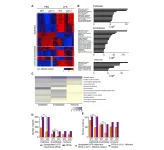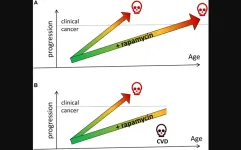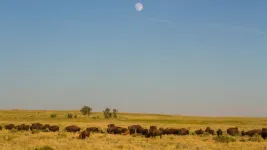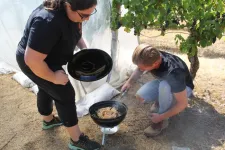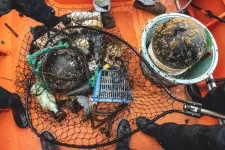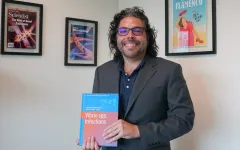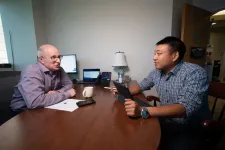(Press-News.org) Blind or colorblind people can describe colors and use expressions like “green with envy” or “feeling blue.” A hearing-impaired person can also say those same vibrant hues are “loud.” But many linguists and cognitive neuroscientists have assumed that somatosensation—touch, pain, pressure, temperature, and proprioception, or the sense of where your body is oriented in space—is fundamental for understanding metaphors that have to do with tactile sensations. Understanding expressions like “she is having a tough time” or “that class was hard,” it was believed, requires previous experience with those sensations to extend their meaning to metaphors.
Now, research from the University of Chicago with a unique, perhaps one-of-a-kind individual, shows that you can comprehend and use tactile language and metaphors without relying on previous sensory experiences. These findings challenge notions of embodied cognition that insist that language comprehension and abstract thought require direct memory of such sensations.
Life without somatosensation
Since 2014, Peggy Mason, PhD, Professor of Neurobiology, has been working with Kim (who agreed to be identified by her first name), a woman who was born without somatosensation. She does not have sensory nerve fibers to feel her body. This includes proprioception, so she cannot walk or stand independently due the difficulty of maintaining balance.
Because Kim can’t perceive tactile sensations, she relies on other senses to perceive the world. For example, to determine the hardness of an object, she listens to what kind of sound it makes when she strikes it against a surface. She relies on visual cues to determine textures, but since she has never experienced those sensations directly, she has no stored memories or experiences to refer to later when using language and metaphors. Nevertheless, on a multiple-choice test that asked users to select the best sensory expression to complete a sentence, Kim performed just as well as controls.
“Phrases like ‘driving a hard bargain’ are extensions of words that have a very sensory root,” Mason said. “Since Kim has no somatosensation, we really wondered how she would deal with this. But we see that while sensory experiences could be very important to many people, it’s not required. You can learn this too.”
To investigate Kim’s use of language, Mason, a neurobiologist who studies empathy and other pro-social behaviors, collaborated with two faculty from the UChicago Department of Linguistics: Jacob Phillips, PhD, a Humanities Teaching Fellow, and Lenore Grenoble, PhD, the John Matthews Manly Distinguished Service Professor. Grenoble said that Kim provided a unique opportunity because until now, ideas about language and metaphors derived from somatosensation simply couldn’t be tested.
“Kim is a gift in that respect because we can test things with her that we can't possibly test otherwise, since everyone has had some of this experience. Some people have lost it, but they have a memory of it to draw on,” she said. “She's just never had it and that's unique. It may be a case study of just one, but it's a pretty powerful one.”
Learning through association vs experience
In addition to Kim, the researchers recruited two control groups to take the test. Thirty-nine native speakers of American English were recruited online, and 24 of Kim’s friends and family were recruited to account for potential differences between the use of idiomatic expressions within Kim’s social circle and the average English speaker. The online quiz featured 80 questions with short vignettes of a sentence or two that were followed by a choice of four idiomatic expressions. For example:
Liza bought her first car and successfully negotiated the price down five thousand dollars. Liza:
a) drove a hard bargain. (correct answer)
b) made a rough guess.
c) missed the mark.
d) hit the hay.
Kim performed as well or better than the control groups, identifying the correct response for nearly every example including both tactile and non-sensory expressions. Grenoble says this lays down a marker in the debate about embodied cognition and metaphor.
“Now we have data to show which side of the debate is correct, and that is you don't have to have somatosensory experience. That opens gateways to really understanding how these things are acquired, how they change, and how they're used for all kinds of things,” she said.
While Kim aced the multiple-choice exam, the paper describes an interaction that gives insight into her experience of the world. The researchers were discussing the word “gritty” with Kim and her mother, and Kim said that she assumed grits, the food, must be gritty because it uses the same root word. Her mother pointed out that cooked grits are definitely not gritty, and Kim responded:
“I think pretty literally about words, especially words about, like you know, sensation and things like that. [...] A lot of times words like we’re talking about ‘gritty’ or like ‘soft’ or ‘hard’ or, like I’m trying to think of examples, like ‘coarse.’ My definitions come strictly from what other people have told me, so that’s where I’m getting it from.”
Grenoble said this experience shows that while direct experience helps, the way Kim interprets these expressions may not be much different than how everyone else does.
“I actually think that most people learn it through association, because they are metaphors. They aren't literal meanings, so, you have to understand how to interpret the metaphor,” she said. “What Kim is really showing us is that you're interpreting it linguistically, because she's got nothing else.”
Mason, who has also published research on how Kim and another person lacking sensation use visual cues to develop a sense of their bodies in space, said she looks forward to working with Grenoble and Phillips on more projects about how Kim describes objects and uses gestures.
“Kim has been an incredible study participant, verging on being a co-author on some of these studies,” she said. “This has been a blossoming and very enjoyable collaboration with such a unique individual.”
The study, “The unembodied metaphor: Comprehension and production of tactile metaphors without somatosensation,” is published in Frontiers in Communications. It was supported by the Neubauer Collegium for Culture and Society at the University of Chicago.
END
Can you describe a sensation without feeling it first?
Research with a person born without somatosensation shows that direct sensory experience is not required to understand language and abstract metaphors referencing that sensation
2023-04-17
ELSE PRESS RELEASES FROM THIS DATE:
p21 facilitates chronic lung inflammation via epithelial and endothelial cells
2023-04-17
“Our results implicate p21 as a critical regulator of chronic bronchitis and a driver of chronic airway inflammation and lung destruction.”
BUFFALO, NY- April 17, 2023 – A new research paper was published on the cover of Aging (listed by MEDLINE/PubMed as "Aging (Albany NY)" and "Aging-US" by Web of Science) Volume 15, Issue 7, entitled, “p21 facilitates chronic lung inflammation via epithelial and endothelial cells.”
Cellular senescence is a stable state of cell cycle arrest that regulates tissue ...
International clinical trial conducts head-to-head comparison of open versus minimally invasive surgery for early-stage cervical cancer
2023-04-17
COLUMBUS, Ohio – Gynecologic surgeons with The Ohio State University Comprehensive Cancer Center – Arthur G. James Cancer Hospital and Richard J. Solove Research Institute (OSUCCC – James) are leading an international clinical trial to determine whether minimally invasive surgery robotic surgery is better or worse than open surgery when performing a radical hysterectomy to treat cervical cancer.
Although minimally invasive and robotic-assisted surgery techniques have become the standard approach for many surgeries, in gynecologic cancer open surgery – which involves one ...
nPOD honors Estefania Quesada Masachs for type 1 diabetes discoveries
2023-04-17
LA JOLLA, CA—La Jolla Institute for Immunology (LJI) Instructor Estefania Quesada Masachs, M.D., Ph.D., has won the 2023 Young Investigator of the Year Award from the Network for Pancreatic Organ donors with Diabetes (nPOD). This prestigious award recognizes Quesada Masachs' groundbreaking research in type 1 diabetes.
Quesada Masachs says she was "happily surprised" to receive the award from nPOD at their 2023 conference. The organization provides pancreatic tissue samples to researchers, opening the door for in-depth research into type 1 diabetes, an autoimmune disease where the body's own immune ...
Cancer prevention with rapamycin
2023-04-17
“[...] long-term treatment with rapamycin slows down aging, a major risk factor for cancer [...]”
BUFFALO, NY- April 17, 2023 – A new research perspective was published in Oncotarget's Volume 14 on April 14, 2023, entitled, “Cancer prevention with rapamycin.”
The mTOR (Target of Rapamycin) pathway is involved in both cancer and aging. Furthermore, common cancers are age-related diseases, and their incidence increases exponentially with age. In his new research perspective, Mikhail V. Blagosklonny, M.D., Ph.D., from Roswell Park Comprehensive Cancer Center discusses rapamycin and other rapalogs and their ...
Temperature, drought influencing movement of Plains bison
2023-04-17
It epitomizes the Great Plains in spirit and in form: a 2,000-pound tank on hooves, cloaked in shaggy winter-tested coat, capped by horns acting as warning and weapon.
Even its scientific name, Bison bison bison, seems to conjure an echo worthy of its majesty. Still, the implacable profile of the Plains bison — the national mammal of the United States and largest on the continent — belies the vulnerability in its history, which saw its legions decimated from tens of millions to just a few hundred in the span of a few colonial centuries.
Conservation efforts have pushed its number back to roughly 20,000, and its status from endangered ...
Oregon State researchers make breakthrough in understanding the chemistry of wildfire smoke in wine
2023-04-17
CORVALLIS, Ore. – Oregon State University researchers have discovered a new class of compounds that contributes to the ashy or smokey flavors in wine made with grapes exposed to wildfire smoke.
This development is significant for winemakers who have struggled to combat the impact of smoke on grapes at a time when climate change is leading to an increase in the number and severity of wildfires, the researchers said.
“These findings provide new avenues for research to understand and prevent smoke taint in grapes,” said Elizabeth Tomasino, an associate professor of enology ...
Coastal species persist on high seas on floating plastic debris
2023-04-17
The high seas have been colonized by a surprising number of coastal marine invertebrate species, which can now survive and reproduce in the open ocean, contributing strongly to the floating community composition. This finding was published today in Nature Ecology and Evolution by a team of researchers led by the Smithsonian Environmental Research Center (SERC) and the University of Hawai‘i (UH) at Mānoa.
The researchers found coastal species, representing diverse taxonomic groups and life history traits, in the eastern North Pacific Subtropical Gyre on over 70 percent of the plastic debris ...
UCF researchers create digital map of sympathetic nervous system
2023-04-17
UCF Researchers Create Digital Map of Sympathetic Nervous System
A team of UCF College of Medicine researchers has created a digital topographical map of the cardiac sympathetic neural network, the region that controls the body’s heart rate and its “fight-or-flight” response. They hope this map will eventually serve as a guide to treat cardiovascular conditions using bioelectronic devices.
The study, led by Dr. Zixi Jack Cheng, a neuro-cardiovascular scientist, was published in the Scientific Reports journal ...
UCF scientist publishes book on emergence of new pathogens
2023-04-17
Climate change may be linked to an increase in the emergence of new pandemics, according to a new book published by an internationally recognized College of Medicine microbiologist.
Dr. Salvador Almagro-Moreno has teamed with fellow molecular biologist Dr. Stefan Pukatzki of City University New York – CUNY, to author the book titled Vibro spp. Infections, recently published by Springer Nature and includes the latest scientific research articles in this field from experts worldwide.
The book examines the factors associated with ...
Prime editing shows proof of concept for treating sickle cell disease
2023-04-17
(MEMPHIS, Tenn. – April 17, 2023) Sickle cell disease (SCD) is a serious blood disorder affecting millions of people, primarily those of African descent. A mutation in the gene that encodes a subunit of the oxygen-carrying molecule, hemoglobin, causes the disease. Scientists at St. Jude Children’s Research Hospital and the Broad Institute of MIT and Harvard showed a precise genome editing approach, prime editing, can change mutated hemoglobin genes back to their normal form in SCD patient cells, which restores ...
LAST 30 PRESS RELEASES:
Tracing the quick synthesis of an industrially important catalyst
New software sheds light on cancer’s hidden genetic networks
UT Health San Antonio awarded $3 million in CPRIT grants to bolster cancer research and prevention efforts in South Texas
Third symposium spotlights global challenge of new contaminants in China’s fight against pollution
From straw to soil harmony: International team reveals how biochar supercharges carbon-smart farming
Myeloma: How AI is redrawing the map of cancer care
Manhattan E. Charurat, Ph.D., MHS invested as the Homer and Martha Gudelsky Distinguished Professor in Medicine at the University of Maryland School of Medicine
Insilico Medicine’s Pharma.AI Q4 Winter Launch Recap: Revolutionizing drug discovery with cutting-edge AI innovations, accelerating the path to pharmaceutical superintelligence
Nanoplastics have diet-dependent impacts on digestive system health
Brain neuron death occurs throughout life and increases with age, a natural human protein drug may halt neuron death in Alzheimer’s disease
SPIE and CLP announce the recipients of the 2025 Advanced Photonics Young Innovator Award
Lessons from the Caldor Fire’s Christmas Valley ‘Miracle’
Ant societies rose by trading individual protection for collective power
Research reveals how ancient viral DNA shapes early embryonic development
A molecular gatekeeper that controls protein synthesis
New ‘cloaking device’ concept to shield sensitive tech from magnetic fields
Researchers show impact of mountain building and climate change on alpine biodiversity
Study models the transition from Neanderthals to modern humans in Europe
University of Phoenix College of Doctoral Studies releases white paper on AI-driven skilling to reduce burnout and restore worker autonomy
AIs fail at the game of visual “telephone”
The levers for a sustainable food system
Potential changes in US homelessness by ending federal support for housing first programs
Vulnerability of large language models to prompt injection when providing medical advice
Researchers develop new system for high-energy-density, long-life, multi-electron transfer bromine-based flow batteries
Ending federal support for housing first programs could increase U.S. homelessness by 5% in one year, new JAMA study finds
New research uncovers molecular ‘safety switch’ shielding cancers from immune attack
Bacteria resisting viral infection can still sink carbon to ocean floor
Younger biological age may increase depression risk in older women during COVID-19
Bharat Innovates 2026 National Basecamp Showcases India’s Most Promising Deep-Tech Ventures
Here’s what determines whether your income level rises or falls
[Press-News.org] Can you describe a sensation without feeling it first?Research with a person born without somatosensation shows that direct sensory experience is not required to understand language and abstract metaphors referencing that sensation
